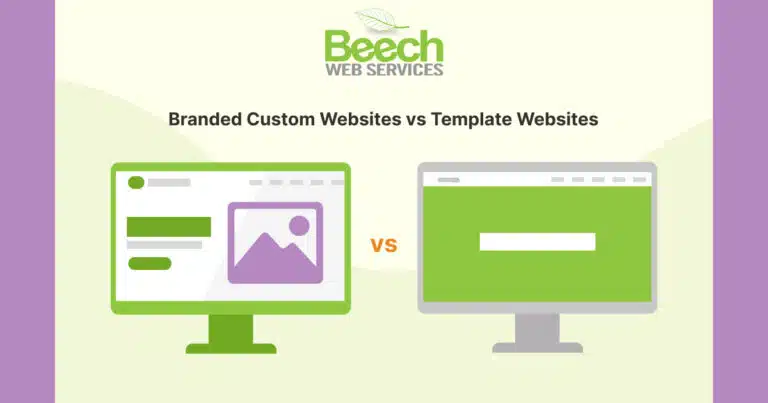Can I get away with adding a logo to a pre-made website design to beat the competition? The answer is no!
In today’s competitive, fast-growing online environment, where ranking in Search Engine Results Page (SERP) and connecting with the target audience could be the difference between selling and sinking, a template website can leave a brand struggling to make an impact.
A website offers the opportunity of full control over online promotion and how a business is presented to the target audience. While they may offer a quick, hassle-free launch, template websites lack the functionality, control, and design elements provided by a custom build. Here’s why a bespoke website tailored to the brand, and optimised for search engines, is the secret weapon a business needs to promote itself online.
Standing out – customised vs clone websites

Imagine a crowded jungle of industry websites, all promoting themselves using the same basic layout and features. It may look like a clear and proper design for a business, but if everyone does the same thing, how does a potential customer differentiate our brand from potential competitors?
What would make them want to choose you?
Building a fully bespoke, responsive, and easily editable design, with our brand aesthetics, values and aims at the forefront helps us stand out from that crowded jungle and connect with the people who value what we do and the way we do it. In this way it will be more likely to lead to healthy growth online.
A website is one of the main ways our target audience can find out about us. It acts as the hub of our digital marketing strategy. Building a design that reflects the brand can show the personality, values, and unique selling points (USPs) of a business in a clear, user-friendly way. This then translates to a superior user experience (UX) that is more likely to keep visitors engaged and interacting with us, which can also positively inform search engines of our presence.
When taking all of this into consideration, spending time building a website that will effectively connect with people is far more worthwhile than adding content to a simple template. So where do we start?
The power of details: every website element counts

When opting for a more customisable and bespoke choice, we can really show off the brand! A website is the only platform online where we have full control over the design, functionality and user experience of our audience. It’s an opportunity for businesses to capture their visitor in a complete journey, starting with the search engine, and ending with an enquiry or conversion. With this control, it’s even more important to pay attention to every element of our website’s design, and how our target audience may perceive it.
Think of a website as the landing page in an ongoing conversation with the ideal customer. To meet our goals, convert our audience and draw attention to the business, we must consider everything that they may see, read or interact with. For this reason, keeping a brand presence across a website can have a dramatic impact.
So, where are the best places to highlight our branding?
- Colour schemes: We can use colour in various places across a website to help improve the overall design and to draw the eye of our customers to specific touchpoints. Colour can be used in the background, on sections and page headings, on buttons and calls to action and even in the customised graphics we choose to represent our brand.
- Imagery: It’s crucial to choose images that reflect who we are and what we can offer our audience. Hero images, product photos, blog post visuals and embedded social media content and even videos on a website all help to confirm to visitors that we do what we say we do. We’d also recommend using alt tags across all imagery to improve a website’s SEO value further.
- Calls to action: Our branding can be present even in the buttons visitors press to get in touch, book a meeting or buy a product. From the choice of colour and text style to the very words we use to push our tone of voice and message to our target audience, calls to action are an essential element of any website and a brand should utilise them to their full potential.
- Messaging: A brand’s tone of voice should be present and consistent across all its online platforms. This includes the likes of social media content, product descriptions, blog posts, and any text written on the website about the business and its services.
All these details can help to visually signpost our brand via the website. Now, it’s also important to factor in the experience of the customers once they’ve landed on the homepage.
Beyond appearances: build an engaging user experience (UX)

Our brand is the heart and soul of any business, encompassing not just visual elements but also the UX and the journey a visitor may take to interact with us. A website built for branding goes beyond just a logo or visual appeal. To capture the attention of our audience in a competitive and highly saturated market, the website we use to promote our brand has to carry a positive experience throughout. This means fast loading and page speed, removing any broken links or page not found errors, displaying the content in a way that is easy to digest and much more.
The benefit of a bespoke and custom website is that we have full control over how it works. This means we can create an engaging experience from start to finish, keeping our target audience engaged. This is unlike a template builder, where control may be limited and restrictive.
Building a seamless, efficient and engaging UX not only strengthens brand identity but also improves the engagement time of the users visiting our site and reduces the bounce rate (users leaving after one page), both of which are factors in a website’s SERP ranking. A brand can capitalise on these benefits with a custom-designed website, optimising every factor of the experience to what their customer wants or expects, which can also significantly help a brand’s reputation amongst the competition online.
Creating the full experience means we miss nothing out, and we represent ourselves in the best way possible!
Don’t forget brand values!

Unlike a template, a bespoke designed website can capture the personality of a brand. This is essential for businesses that want to promote their core values and find customers within their target audience who share them.
For example, a business valuing sustainability wouldn’t want a website that uses unnecessary resources and increases its digital carbon footprint. Because this goes against their brand values, it also could create mistrust between them and their audience.
Being authentic online means showing our target audience that we support consistent core values in everything our business does. Part of our branding is formed from the voice, message and values of our business, and the website should always reflect that.
Why a templated website won’t perform as well

Some templates are better than others and may seem like an attractive choice for businesses starting out. They offer a convenient starting point, particularly for providing brands with various basic website creation tools and stock imagery.
However, they often come with significant limitations that can hinder a business’s growth overall. In particular, the restricted customisation options available can stifle the creativity and individuality of the brand.
And if those aren’t enough reasons to avoid templated websites, we’ve listed their main limitations below.
- Lack of flexibility: Templates provide website owners with a structured framework for website creation, though they often impose strict design and layout constraints that limit the ability to tailor the site to specific brand criteria. As a result, businesses could find themselves constrained by the template’s predetermined layout, colour schemes, and functionality, affecting their brand’s online presence when compared to other, more customisable platforms like WordPress.
- Generic designs: Less thought-out designs can fail to capture the true essence of a brand, making it difficult to stand out in a crowded marketplace and connect with target audiences on a deeper level.
- Brand dilution: Creating a cookie-cutter-style website does not convey the uniqueness of any business. Brand authority and a business’ identity online is incredibly important to potential customers. The user’s desire for authentic voices and personality may be lost in a template with no character or originality.
- Limited Search Engine Optimisation (SEO) abilities: Though some template builders may offer SEO services, the likelihood of these strategies matching that of a specific, more personalised development is low. To improve search engine rankings and increase the chance of driving more organic traffic to our website, attention to detail and an SEO strategy is necessary!
In summary
Using the available tools and template builders for a new website can be a great, low-budget beginning in our online journey. But, to allow a business to grow and deliver to a wider target audience, we must take advantage of the long-term benefits presented to us by a custom and bespoke design.
Tailor a user experience, invest in your branding from the second a visitor lands on the homepage and make your website the perfect online advertisement for who you are and what your brand can do for its customers. Get in touch with us to start your website project!












